 |
 |
| Home | Welcome | What's New | Site Map | Glossary | Weather Doctor Amazon Store | Book Store | Accolades | Email Us |
 | |||||||||||||||||||||||||||||||||||||||||||||||||||||||||||||||||||||||||||||||||||||||||
The Northern Hemisphere Heat
|
|||||||||||||||||||||||||||||||||||||||||||||||||||||||||||||||||||||||||||||||||||||||||
| Country | New Record Temperature | Date: 2010 |
| Belarus, Gomel | 39.2°C (102.5°F) | 8 August |
| Chad, Faya | 47.6°C (117.7°F) | 22 June |
| Cyprus, Lefconica | 46.6°C (121.3°F) | 1 August |
| Finland, Joensu | 37.2°C (99°F) | 29 July |
| Iraq, Basra | 52.0°C (125.6°F) | 14 June |
| Kuwait, Abdalyh | 52.6°C (126.7°F) | 15 June |
| Jordan, Marka Amman | 43.5°C (110.3°F) | 20 August |
| Niger, Bilmar | 48.2°C (118.8°F) | 23 June |
| Mayanmar (Burma) Myinmu | 47.2°C (117°F) | 14 May |
| Qatar, Doha Airport | 50.4°C (122.7°F) | 14 July |
| Pakistan, MohenjuDaro | 53.5°C (128.3°F) | 26 May |
| Russia (Europe), Utta, Lalmykia Republic | 45.4°C (113.7°F) | 12 July |
| Russia (Asia), Ust Kara, Chita Republic | 42.7°C (108.9°F) | 24 June |
| Saudi Arabia, Jeddah | 52.0°C (125.6°F) | 22 June |
| Sudan, Dongola | 49.7°C (121.5°F) | 25 June |
| Ukraine, Lukhansk | 42.0°C (107.6°F) | 12 August |
The national record summer heat marks set during 2010 are shown in the table above that also includes an astonishing temperature of 53.5°C (128.3°F) recorded in Pakistan in May 2010, which is the second hottest, undisputed temperature ever recorded on the planet, and the hottest ever recorded in Asia. (Two higher readings, one measured at Al Azizia, Libya in 1922 and another at Tirat, Zvi Israel in 1942, have been disputed as to their validity.)
The summer of 2010 rated as the fourth hottest in US climate records. Fifteen U.S. cities recorded their warmest summer (June-August) ever including New York City, New York; Washington, DC; Philadelphia, Pennsylvania; Trenton, New Jersey; Baltimore, Maryland; Greenville, South Carolina; Little Rock, Arkansas, and Tampa and Miami, Florida. For Baltimore, Trenton; Atlantic City, New Jersey and Washington DC, July 2010 now stands as their warmest month ever; In Houston Texas, August 2010 now holds that distinction. Among the cities that recorded their all-time highest temperature reading are: New York City, New York; Hartford, Connecticut (tie); Philadelphia; Pennsylvania; Los Angeles, California, Trenton, New Jersey; Wilmington, Delaware; Baltimore, Maryland: Norfolk, Virginia (tie); Asheville, North Carolina, and Tallahassee, Florida (tied).
The heat wave was most intense in June over the eastern United States, with the heat peaking in early July as a strong Bermuda High hung along the coast. Temperatures climbed above 100°F (38°C) from the Carolinas to New England covering the cities of Raleigh, North Carolina; Washington DC; Baltimore, Maryland; Wilmington, Delaware; Philadelphia, Pennsylvania; Newark, New Jersey; New York, New York; Hartford, Connecticut; and Boston, Massachusetts. Baltimore hit an all-time record of 105°F (40.6°C) on 6 July; and Hartford, Connecticut tied its hottest temperature at 102°F (38.9°C). New York City set a new all-time record the following day with 103°F (39.4°C).
The heat spread westward in July into the Mideast and Midwest, where high humidity added to the discomfort and danger. The Heat Index in Newton, Iowa hit a steaming 128 °F (53C). High heat indices caused intolerable conditions in Chicago, Illinois; Omaha, Nebraska; St Louis, Missouri; and Des Moines, Iowa. Joplin, Missouri hit 106°F (41.1°C) and Iowa City, Iowa topped out at 103°F (39.4°C).
 By mid-July, the heat had settled over the Plains states with temperatures exceeding 104°F (40°C) in many locations: Hill City, Kansas, 109°F (42.7°C); Syracuse, Kansas, 108°F (42.2°C); Imperial, Nebraska, 107°F (41.7°C); Garden City, Kansas, 106°F (41.1°C); Yuma, Colorado, 105°F (40.6°C); San Angelo, Texas, 105°F (40.6°C).
By mid-July, the heat had settled over the Plains states with temperatures exceeding 104°F (40°C) in many locations: Hill City, Kansas, 109°F (42.7°C); Syracuse, Kansas, 108°F (42.2°C); Imperial, Nebraska, 107°F (41.7°C); Garden City, Kansas, 106°F (41.1°C); Yuma, Colorado, 105°F (40.6°C); San Angelo, Texas, 105°F (40.6°C).
Later in July, the Southeastern states baked. Waynesboro, Georgia hit 105°F (40.6°C) on the 10th Crestview and Marianna, Florida peaked at 100°F (38°C) on the 23rd. Norfolk, Virginia tied its all-time record with a high of 105°F (40.6°C) on 25 July while Richmond and Stoney Creek, Virginia set daily marks at the same temperature. Enterprise and Hamilton, Alabama hit 102°F (38.9°C) 25 July. Athens, Georgia soared to 103°F (39.4°C) on the 26th. Waynesboro, Georgia hit 104°F (40°C), and Waycross, Georgia reached 103°F (39.4°C) on the 27th. Lakeland. Florida sizzled at 102°F (38.9°C) on 28 July. Marianna, Florida cooked at 104°F (40°C) on the 30th while Tallahassee baked at 103°F (39.4°C) and Jacksonville steamed at 102°F (38.9°C). Albany, Georgia closed the month with a 103°F (39.4°C) reading.
In the normally hot Death Valley, California, the temperature in July 2010 equaled or surpassed 120°F (49°C) on 11 days, with a string of six such days, though none was a daily record. Still, the site was the hottest in the national on all but two days in July. Death Valley did set two daily records in August, however, reaching 122°F (50°C) on 25 and 26, August. The two days in July where Death Valley was not the US’s hottest, that distinction fell in Arizona at Bullhead City (116°F (46.7°C)) and Gila Bend (115°F (46.1°C)). Youngtown, Arizona set a new daily record of 113°F (45°C) on the 1st, and the following day Ajo also hit that mark to tie their record. Las Vegas, Nevada saw its high temperature surpass 100°F (38°C) on every day in July, a string that had not occurred since 1988. The string extended to 45 days, though impressive, it was still well below the longest such streak ever: 66 days in 1944.
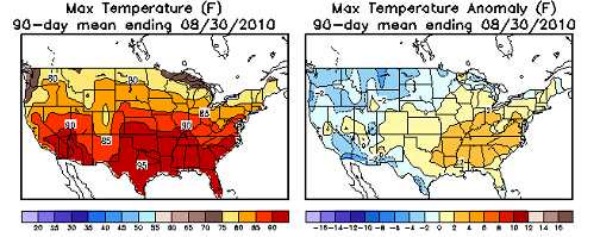
The heat ,which was absent for much of the summer in the Pacific Northwest, arrived in August bringing record temperatures to cities in Washington State, Oregon, Idaho, and Alaska. Cave Junction, Oregon sizzled at 107°F (41.7°C) on both 16 August and 25 August. Medford, Oregon soared to 105°F (40.6°C) on the 25th. Riggins, Idaho reached 105°F (40.6°C) on 26 August, and Boise, Idaho, 104°F (40.0°C) the following day. Eugene, Oregon hit 101°F (38.2°C) on 14 August. Olympia, Washington peaked at 95°F (35°C) on the 14th as did Seattle-Tacoma, Washington. A day later, Olympia had warmed to 97°F (36.1°C) while Seattle-Tacoma and Aberdeen, Washington reached 96°F (35.5°C). On 16 August, Newhalem, Washington went to 98°F (36.7°C) with Baring, Washington at 97°F (36.1°C). The heat even reached into Alaska as Fairbanks reached 91°F (33°C) on 15 August, only the fifth time temperatures here have surpassed 90°F (32°C) since 1904 when official record keeping began. Central, Alaska also reached that temperature on the same day. Several Alaska locations set daily records in July at 85°F (29.4°C) including the community of North Pole. (Alaska also saw 71 daily temperature records fall and 23 tied in September, the highest being 75°F (24.4°C) at Haines and Yakutat.)
California too saw the real heat of the summer of 2010 arrive in August, following a cool summer along the coast, as 108 new high temperature records were set (compared to 11 in July). Most of the heat came late in the month. Death Valley exceeded 120°F (48.9°C) three times, with peaks of 122°F (50°C) on 25 and 26, August, and 110°F (43.3°C) 25 times. The national heat wave continued into September in California with Thermal and Imperial setting daily records at 116 and 115 respectively on the 3rd. In the first week of the month, Baker, Blyth, Death Valley, Imperial, and Thermal, all exceeded 110°F (43.3°C).
Later in September, a second hot streak covered southern and central Oakland, San Francisco, and Jose, Sacramento, Stockton and Fresno all broke daily temperature records with readings above 95°F (35°C). California. Los Angeles broke its all-time maximum temperature record with a reading of 45°C (113°F) on the 27th, which was the state’s hottest day of the month with 27 new daily records set. Long Beach set a new daily record of 43.9°C (111°F) as did Santa Maria with 40.6°C (105°F). Elsewhere, temperatures at Santa Ana, El Centro and San Diego reached 43.9°C (111°F), also setting daily records. Blyth and Burbank both reached 110°F (43.3°C) on the 27th. Death Valley reached 119°F (48.3°C) twice, once a daily record. Across the state, 149 new daily high temperature records were set during September.
Many cities set records for consecutive days of heat above a certain threshold. Chicago, Illinois saw its high temperature at or above 80°F (26.7°C) for 79 days. Jacksonville, Florida set a new mark for the most consecutive days at or above 90°F (32.2°C) with 50 days. Birmingham, Alabama also set a record for most consecutive days with a high temperature of 90°F (32.2°C) or more with 42. Little Rock, Arkansas saw a similar streak reach 60 days. San Angelo, Texas climbed over 100°F (38°C) for an all-time record 26th consecutive days.
Canada recorded its third hottest summer in 2010. British Columbia was particularly hot in August as wildfires raged. Normally temperate Victoria, on Vancouver Island, set new high temperature records on three consecutive days reaching a peak of 33.4°C (92°F) on the 14th. Chilliwack hit its highest mark ever with a 35.7°C (96°F) reading.
Even Africa experienced record heat in the summer of 2010. Chad, Niger and the Sudan experienced their hottest days in recorded history during the latter days of June. Faya, Chad had set a new national mark at 47.6°C (117°F) on 22 June. Bilma, Niger established a new mark at 47.1°C (116.8°F) on 23 June then broke that record with 48.2°C (118.8°F) the following day. Dongola, Sudan peaked at 49.7°C (121.5°F) on 25 June, for a new Sudanese record. Algeria and Morocco also experienced intense heat in mid-July. In late July, another round of heat approached record levels over Chad and Niger.
Sandstorms and drought continued to plague North Africa causing crop failures and compounding the famine that has swept many areas for some years.
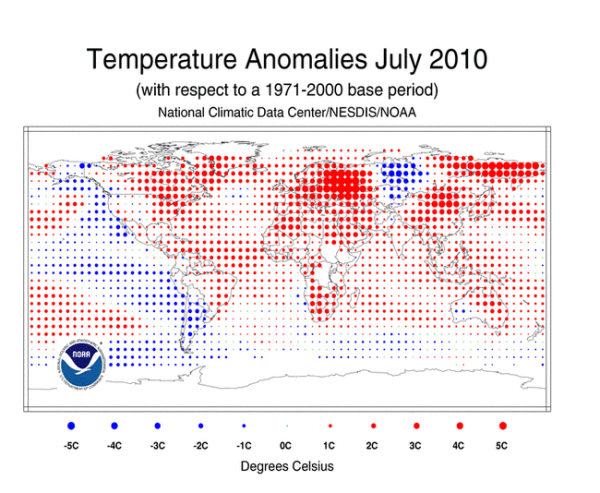
Though high summer temperatures are common in the deserts of the Middle East, the heat wave of 2010 took temperatures to new heights in the recorded weather history of several nations. Bahrain, Iraq, Israel, Lebanon, Jordan, Kuwait, Qatar and Saudi Arabia all experienced temperatures above 43°C (109.4°F), only one, Jordan, did not exceed 45°C (113°F) and five pased 50°C (122°F). The hottest days are shown in the following table.
| Country | Highest Temperature | Date: 2010 |
| Bahrain | 46.9°C (116.4°F) | 20 June |
| Iraq, Basra | 52.0°C (125.6°F) | 14 June |
| Israel, Kubbutz Almog (occupied West Bank) | 51.4°C (124.5°F) | 7 August |
| Kuwait, Abdalyh | 52.6°C (126.7°F) | 15 June |
| Jordan, Marka Amman | 43.5°C (110.3°F) | 20 August |
| Lebanon | 47.6°C (117.7°F) | na |
| Qatar, Doha | 50.4°C (122.7°F) | 14 July |
| Saudi Arabia, Jeddah | 52.0°C (125.6°F) | 22 June |
Severe sandstorms plagued Saudi Arabia and Iraq. In Kuwait, high humidity pushed the heat index at Al-Nuwaiseeb to 64°C (147°F) in August. In Israel, summer-like heat lasted until December. Lebanon saw its worst drought in eighty years.
The 2010 summer was the hottest summer on record for Europe as a whole, breaking the mark set in 2006 by over half a Celsius degree. The extreme heat covered nearly all of Europe but hit Eastern Europe hardest with European Russia seeing the worst, as heat and drought led to intense wildfires.
Western Europe saw many new daily temperature records set in France, Germany, Belgium, Austria, Switzerland, and Denmark. Brussels, Belgium had its hottest day in 25 years on 2 July. In general, however, the hottest day of the summer occurred in Western Europe on 12 July. Parts of Germany sweltered at 38°C (100°F). Many cities including Berlin hit record highs during the summer. Switzerland came close to breaking its all-time highest temperature when Sion reached 39.4°C (103°F) on 13 July, A daily record high of 34.8°C (94.6°F) hit Basel that same day.
Though temperatures were not as hot in the United Kingdom — the highest registering at 31.7 °C (89.1 °F), in Gravesend, Kent — a heat wave warning was issued by the Met Office during the period 9-16 July for southeast England and East Anglia. London reached 31°C (87.8°F) during the period.
Southern Europe had temperatures exceed 40°C (104°F) on several occasions. In Athens, Greece, the thermometer hit 43°C (109°F) on 16 June. In July, the Iberian Peninsula baked for three weeks with temperatures up to 44°C (111°F). Madrid, Spain climbed to 41°C (106°F) and Pataias, Portugal sizzled at 40°C (104°F) on 27 July. Wildfires blazed across northern Portugal.
On 1 August, Nicosia, Cyprus soared to a breathtaking 45.6°C (114°F), its hottest temperature in over a century while Lefconica recorded Cyprus’s hottest temperature in its history when the mercury peaked at 46.6°C (115.9°F).
Italy experienced its highest temperatures in mid-July with readings from 35-40°C (95-104°F) in Bolzano, Brescia, Florence, Genoa, Milan, Perugia, Rome, Turin, Trieste, Venice, Campobasso, Civitavecchia, Frosinone, Latina, Messina, Rieti, Verona and Viterbo, all of which were on maximum heat alert.
If the situation was not hot enough, Eastern Europe and Russia simmered throughout the summer of 2010. The hottest areas spanned a wide swath that included western Russia, Belorussia, the Ukraine, and the Baltic nations. Finland, Belarus, The Ukraine, and Russia all set new national temperature records during the summer, and many local records were set there and in cities in Poland, Hungary, The Czech Republic, Bulgaria, Serbia, and Romania. The Czech Republic exceeded 37.8 °C (100.0 F) on three consecutive days in mid-July.
In Finland Utti, Lahti, Heinola, and Puumala had a total of 27 July days (out of 31) that observed maximum temperatures exceeding 25°C (77°F), setting new records for number of hot days.
By mid-June, Bulgaria became the European hot spot as the temperature rose to 37.2 °C (99.0°F) in Ruse. Several Bulgarian cities set new high temperature records, one just missing the national record high of 37.5 °C (99.5 °F): Vidin, Sandanski, Lovech, Pazardzhik, and the capital, Sofia.
In the Ukraine, Kiev broke its record high on 12 June with a reading of 34°C (93.2°F). Temperatures rose to levels over 30°C (87°F) in Minsk, Ukrainian Galicia and the Crimea peninsula at this time. Temperatures again rose across the Ukraine in early August, with readings in the 35–40°C (95–104 F) range. The Ukrainian national record for high temperature fell on 12 August when Lukhansk peaked at 42.0°C (107.6°F).
Belarus reached its hottest temperature ever on 6 August when the mercury hit 38.9°C (102.0°F) in Gorky. Other former republics in the old Soviet Union Georgia and Kazakhstan, suffered from heat as temperatures there reached the 40°C (104°F) mark.
After a frigid winter in Russia, the heat began in mid-summer and lasted into the early autumn (September) with western Russia being the hotspot of the globe in July. The heat and drought took its toll on the nation. Approximately 22 million hectares of crops succumbed to the extreme heat and drought, an estimated 20 percent of the nation’s crops, including grain, vegetable, and fodder. Several hundred wildfires broke out across Russia, primarily in the west regions, starting in late July. The blazes forced Russian President Dmitry Medvedev to declare a state of emergency in seven regions. These wildfires cost roughly $15 billion USD in damages.
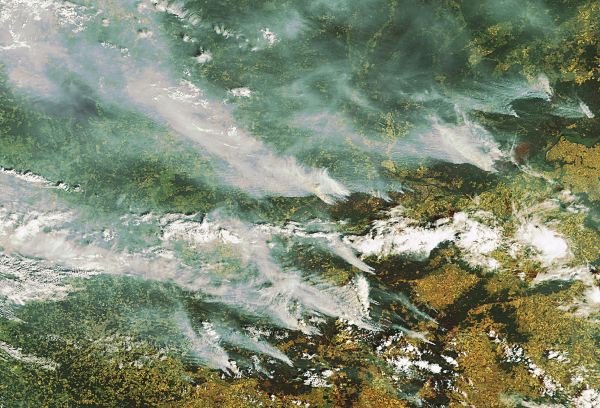
Heat and poor air quality due to smoke from wildfires that blazed across the region during July took their toll on human health as well. At least 15,000 people died due to the heat wave alone across Russia, but insurance giant Munich Re estimated 56,000 people perished from the combined effects of smog and the heat wave. An estimated 14,300 people died in Moscow alone. More than 1,600 people trying to escape the heat drowned across Russia, many caused by increased alcohol consumption.
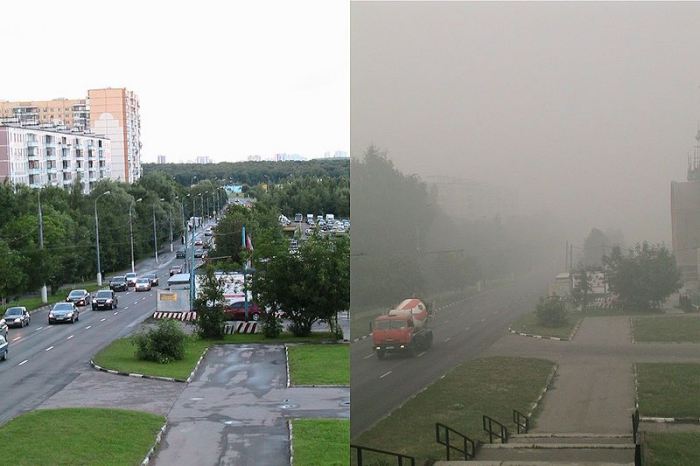
On 14 July, the mercury hit 31°C (87°F) in Moscow, the first of a 33-day stretch on which the maximum temperatures reached 30°C (86°F) or higher. Moscow broke its old high temperature record, then re-broke it several times during the season. Moscow’s old heat record was equaled or exceeded five times during a two-week period from 26 July to 6 August. On 29 July, the temperature soared to 38.2°C (100.8°F), the first time that Moscow had reached the 100°F level. That mark was tied on 6 August. By mid-August when the heat finally broke, Moscow had set many daily high temperature records, a total that reached 23. Deaths attributed to the stifling heat and poor air in Moscow rose to 700 per day. Smog due to wildfires and photochemical pollution contributed to the death toll. Moscow’s average July 2010 temperature ranked as the warmest month in the 130-year climate record for the city.
Elsewhere in Russia, temperatures also soared to record levels in both the European and Asian portions of the nation. Both set new all-time temperature records with a reading of 42.7°C (108.9°F) on 27 June in Ust Kara, Asia Russia, and 45.2°C (113.7°F) in European Russia on 11 July at the Utta hydrological station in the Kalmykia Republic. Yashkul (Jashkul), Kalmykiya recorded a high temperature above 37.8°C (100°F) for eighteen straight days beginning 27 July, most were over 40°C (104°F). The peak during this stretch was 43.5°C (110°F). For the summer, the 37.8°C (100°F) mark was topped on 37 days.
Central Moscow hit 39.0°C (102.2°F); Saint Petersburg peaked at 37.1°C (98.8 F), its highest temperature ever. A number of cities exceeded 40°C (104°F) included Rostov on Don, Ryazan, Samara, Voronezh, Volgograd and Saratov. Boguchar ended July with a string of four out of five days above 40°C (104°F), and seven out of nine stretching into early August. The hottest day was 3 August when the mercury soared to 41.9°C (107.4°F) .Penza saw four-straight days of 40°C (104°F) heat end 1 August.
Even the Russian Arctic melted under the heat as Oymyakon, normally one of the coldest places on Earth during the winter, reached 34.6°C (94.3 F) on 28 July. On the Arctic coastal plain, Kazach'ye ended a string of three days above 33°C (91.4°F) with a high of 35.3°C (96°F) on 5 July.
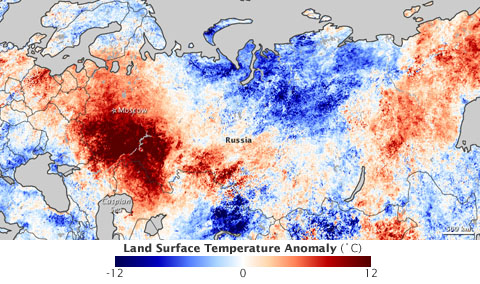
In Siberia, Omsk hit 35.9°C (96.6°F) in late August. The normal high there at this time of year is 19.4°C (67°F). Northeastern Siberia’s famous “pole of cold” region was anything but this summer as the first week of July saw heat unprecedented in their weather annals. Verkhoyansk, which holds the notoriety of having dropped to a low of -68°C (-90.4°F), exceeded 32.2°C (90°F) on three successive days in early July. The 5 July high of 35.3°C (96°F) was the highest temperature there in at least 17 years.
In the eastern Russian region of Amur along the Chinese border, Svobodnyy and Belogorsk reached 42°C (107.6°F) on 27 June. In nearby Chita, near the borders of Mongolia and China, temperatures hit a string of four days with highs reaching at least 37.8°C (100°F). In the Russian Far East, the heat spilled into Chukotka and Magadan. Zyryanka saw three-straight highs between 35°C (95°F) to 37.4°C (99°F) ending on 27 July.
The heat extended southward from eastern Russia into China and Mongolia. Mongolia simmered through temperatures as high as 41°C (106°F) as the heat began on 23 June. The Mongolian capital of Ulaanbaatar experienced a temperature of 38.3 °C (101°F) on 25 June. While there is no report of a record high, this must rank among the highest temperatures reached in the city, which stands more than 1300 meters above sea level. The drought and heat led to an outbreak of wildfires in July.
The autonomous region of Nei (Inner) Mongol and the Chinese Province of Heilongjiang experienced highs of 35-40°C (95-104°F) during the three day period from 22 to 24 June. As July began, the heat spread across China with more that 16 provinces reporting temperatures of 40°C (104°F) or more. Beijing experienced a 41.8°C (107.2°F) temperature on 7 July, the hottest since national records began in 1951. Near record heat waves hit Gansu Province, Guizhou Province, and Nei Mongolia on 5 July. Continued heat in August led to widespread fires in Nei Mongolia as surface temperatures soared to 50°C (122°F). The all-time record for an inhabited area of China was set at Toyoq with a reading of 48.7°C (119.7°F).
In Japan, the 2010 summer was the hottest since records began in 1898. The heat began in mid-July and extended into early autumn with September bringing another heat wave. Japanese officials estimated that over 1700 people died from hyperthermia from July through September. The heat wave amassed days with temperatures of 35°C (96°F) or more frequently during the period. The number of such occurrences in Japanese cities includes: Kumagaya (37 days), Kyoto (33 days), Totorri (29 days), Osaka (25 days), and Hiroshima (24 days).
Tokyo exceeded 30°C (86°F) on a record 71 days during the season. The hottest day of the summer in Tokyo registered 37.2°C (99°F) and for all Japan, the hottest was 39.1°C (102.4°F) in Gujo on 17 August. In early September, at least 128 cities reported highs above this 35°C (96°F) benchmark with Kyotanabe, Kyoto Prefecture experiencing its highest temperature since 1868: 39.9°C (103.8°F) and a new Japanese record for September.
Other Asian nations to suffer from the heat during 2010 including Myanmar where a new hottest-ever temperature was recorded at Myinmu: 47.2°C (117°F) 12 May. Hanoi, Vietnam experienced a heat wave from 29 June to 2 July with daytime temperatures between 35 and 40°C (95-104°F).
On the Indian Subcontinent, one of the hottest “summers” on record preceded the wet monsoon. Temperatures soared to near 54°C (129°F) in parts of Pakistan. The ancient city site of Mohenjo-dar in Pakistan sizzled at 53.7°C (129°F) on 1 June. Nearby Larkana recorded a high of 53°C (127.4°F) a few days earlier. Twelve cities in Pakistan reported highs at 50°C (122°F) or more during May. The hottest place in India was Sri Ganganagar in the northern desert state of Rajasthan at 49.3°C (121°F), with severe heat also prevailing in the adjacent states of Punjab and Haryana. Jaipur recorded a maximum of 44.9°C (112.8°F), Jaisalmer, 48.0°C (118.4°F); Pilani, 47.7°C (117.9°F); and Churu, 46.8°C (116.2°F) on 26 May. The capital of New Dehli simmered on the 26th at 46.3°C (115.3°F).
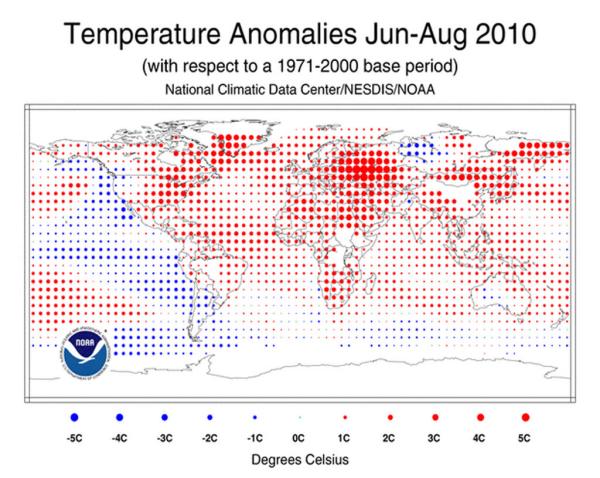
The above synopsis is by no means the complete picture of the extremely hot summer of 2010 in the Northern Hemisphere, not all nations that were within the hot zones have readily available data on the extent of the heat. Few areas of the world are as number-crazed as North America. Given the difficulty in being exact when placing blame on heat for the number of fatalities, we will never know the true death toll, but it surely exceeded ten thousand and may well have exceeded 60,000-70,000, if the Munich Re estimates are correct for Russia.
Are such events rare as some would have us believe, or will they become commonplace as others argue? Only time will truly tell.
 |
Now AvailableThe Field Guide to Natural Phenomena: |
 |
To Purchase Notecard, |
Order Today from Amazon! | |
 |
 |
To Order in Canada: |
To Order in Canada: |


